Patrick Brower started off creating art, and wound up selling it.
Brower grew up “in a household that had comics all the time,” and graduated college with degrees in illustration and art history. He wanted to be a freelance artist, but realized he’d have to have a day job until he built up a client base. He was offered a part-time job at a comic store, which immediately became full-time, which led to… a 17-year stint at the store.
Then, a friend and former co-worker circled back into Brower’s life with a simple idea: “Hey. Maybe we can do this.”
Brower and Dal Bush became business partners and opened Challengers Comics in Chicago in 2008.
“At that point, I never wanted to own a comic shop,” Brower laughs. “I saw how much headache and paperwork and tax problems and not-fun things were wrapped up in it. I never wanted to be the guy who worried about the business aspect. I wanted to be the guy having fun, on the front lines, talking about comics and selling comics. But when one of your best friends comes to you and says, ‘Hey, what if we do do it ourselves?’, you don’t want to look back 10 years after and say, ‘I wish I would have done that.’ So we did.”
Challengers has won a Will Eisner Spirit of Retailing award, and multiple “Best of Chicago” nods from Chicago magazine, Time Out, and Chicago Reader.
“None of that matters nearly as much as opening the store, and doing it our way,” Brower says.
Not that there haven’t been some bumps along the road…
THE BAD
Don’t Force Your Vision“When we started, we had a notion of what kind of store we were going to be,” Brower says. “But you have to listen to your neighborhood and your customers. And they immediately told us that we had some incorrect notions about how to serve them.”
Brower thought Challengers would have a very mainstream, Marvel-and-DC clientele.
“But where we are in the Bucktown area of Chicago, there’s a lot more diversity in reading habits,” he says. “We sell just as many independent books as we do Marvel and DC titles. But it took a little while to get our feet under ourselves in that regard.”
Brower thinks his biggest miscalculation was taking an additional 400 square feet next door and opening an art gallery. For almost two years, they did monthly art shows, even flying in international talent such as Eduardo Risso, Rafael Albuquerque, and Stuart Immonen.
“I had these grand dreams that people would come and sit there to eat their lunch like it was a museum,” Brower says. “But people would walk in, take a lap, and be out in 30 seconds. For the two years we had it, we never made money on that space. It looked great. I loved having it. It was a talking point. But it never took off.”
Have The Right Expectations
“Everybody knows that when you go into business, you expect to lose money for a while,” Brower says. “But we didn’t make the money we thought we were going to right from the get-go.”
Brower’s prior experience running a store was at a major downtown megalith.
“It was a beast. It was huge, and had a ton of foot traffic,” he says. “And it gave me unrealistic expectations of the traffic we’d get at Challengers.”
Brower and Bush had dialed back their expectations, figuring they were a start-up. “But we didn’t dial it back enough,” Brower says. “We had too optimistic a view of what our business would be, and how quickly we could get there. If you look at our business plan from when we were trying to get loans, we are just now in year eight where we projected we would be at after year two.”
Spend Your Money RightLack of money was compounded by marketing mistakes.
“We were undercapitalized, and we spent our money kind of poorly at the beginning,” Brower says. “We spent money on newspaper ads in The Onion, The Reader, and Time Out Chicago. To this day, we have no idea if the ads worked. Even if you do a coupon ad, you have little idea what the actual penetration is. Did people use it? Did they see it, but just not want to hassle with a coupon?”
Brower says Challengers spent “thousands and thousands of dollars on local newspaper advertising just to announce our arrival.” He sees today’s online advertising and social media presence as a stronger buy-in.
“But this was 2008, so not everyone was on Facebook, and Twitter was scarcely around at all,” he says. “And even if we had them, we wouldn’t have had the following, because we weren’t established.
But Challengers righted the ship.
THE GOOD
Cater To The Families“We always had a decent all-ages section,” Brower says. “But on weekends, we would see so many kids and families. We knew we had to grow it, but we didn’t know how. Fortunately, we had this gallery space that, from the minute we leased it, was losing money. So Dal said, ‘Hey, how about we use that?’”
Challengers turned the space into Sidekicks, a store-within-a-store catering to kids.
“From the minute we did that, everything turned around,” Brower says. “When a kid comes in and immediately turns left and goes into Sidekicks, that’s great. They know it’s their place. It’s helped us be able to stock a lot more all-ages material. It’s such a great thing. I wish more comic stores had the space to do all-ages comics rooms, not just sections.”
Focus On Today, And Tomorrow
Focusing on kids and parents pushed Challengers up. Recognizing that not everyone is a dyed-in-the-wool hardcore fanboy kept them up.
“So many people who come into our store are new,” Brower says. “They don’t know who the publishers are. They don’t know that Image Comics publishes Walking Dead; they just want Walking Dead. So we have to make it so they can find it. All of our graphic novels are racked alphabetically; not by publisher.”
Challengers focuses on graphic novels and new single-issue comics. Old issues? They’re yesterday’s news.
“We don’t do back issues—they’re all 99 cents,” Brower says. “We’re not a markup store. We don’t charge more for variant covers; they just go on the shelf with everything else. We’re not a collectibles store; we’re a comic book store.”
Brower thinks their plan keeps things forward-looking.
“One of the thing we pride ourselves on at Challengers is being the store for today’s readers and tomorrow’s readers,” he says.
Polish Your Brand
Appearance matters, and Challengers tries to keep it polished, and consistent.
“All of our signs are professionally printed, either at the store, or we’ll go to FedEx,” Brower says. “You’re not going to find a backer board with a Sharpie-drawn message on it. We do large banners in the windows for events, and it’s got to look good. Everything looks professional.”
Brower says the branding gives off an aura that they’re bigger than they really are.
“We have a very specific color scheme, we have an adaptable logo that goes on everything, and we’re consistent,” he says. “So often, people who have never been to the store before think we’re part of some large national chain!”
AND WHAT ELSE?
“While a store can’t exist solely on the taste of its owners, it can exist on the strengths and attitudes of the owners. Obviously, we can’t carry just the books we like, but we can carry books we think we can sell.“There are two owners at Challengers, and two owners who are in the store equally. There’s no silent partnership. It’s a two-man partnership, and it’s really the summation of both our tastes and opinions. And I think it’s great. What he’s bad at, I’m good at, and vice versa. We play to each other’s strengths, and cover each other’s weaknesses.
“It took a long time to get established. And I’m happy to say that every year we’ve been here, we’ve experienced growth. And as December 2016 starts this year, we’ve already beat last year.
“It’s okay to let something die. For a couple of years, we had a graphic novel rental section. We thought it was a great idea. It was almost like a Netflix model. You paid $9.99 a month, and you got unlimited, one-at-a-time rentals from a specific section. It started off strong, but it slowly died down and we were keeping all this rental stock which just confused customers. They’d come up to the register with a book to buy and we’d say, ‘Oh, no, that’s from our rental section,’ and it just created confusion. It was time to let it die. When you get to the point of diminishing returns and people stop caring, it’s okay to let something go.
“We have two square feet out of 1400 devoted to Magic: The Gathering cards. Just packs, and we only do that because people want them. We don’t do singles; we don’t do tournaments. We find we have to play to our strength, and our strength is being a comic book store. There are plenty of stores in our neighborhood that do tournaments, and we’re happy to refer people to those stores. But I really find myself wishing I could take that two square feet back to do something comic-related. It’s not our identity; it’s not what we do.
“We had some guy here writing an article, looking at the store. He said, ‘Based on what I see here and your internet presence, you guys must do, what? $2 million a year?’ And that was hilarious, because we can’t touch $2 million a year with any type of long-reaching stick. But that’s the appearance we give off.
“I think the best years of the comics industry are yet to come. I think the breadth and diversity of the material is better than it’s ever been. I think no matter who you are and what you do, there’s a comic you will love. We just need to keep convincing new people that this is such a great medium.”
Click gallery below for store images.



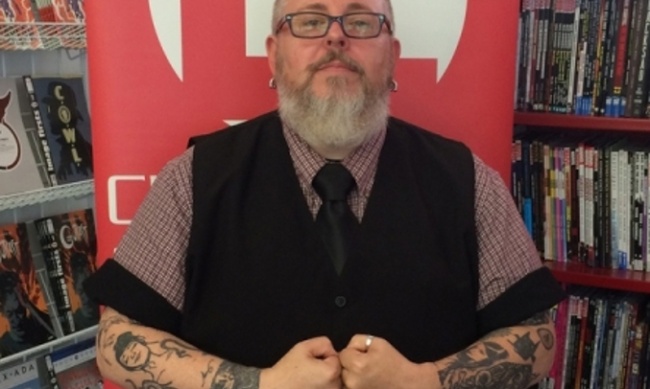
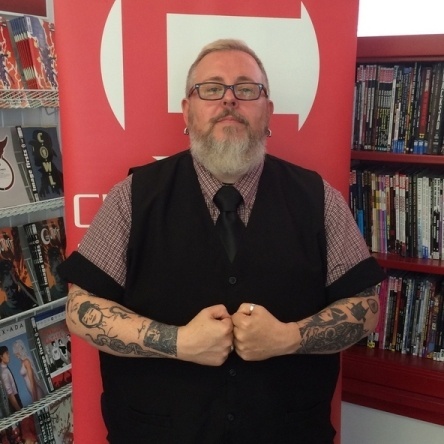
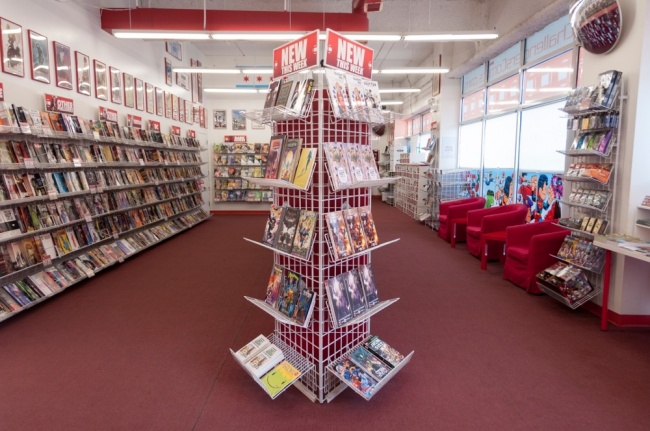
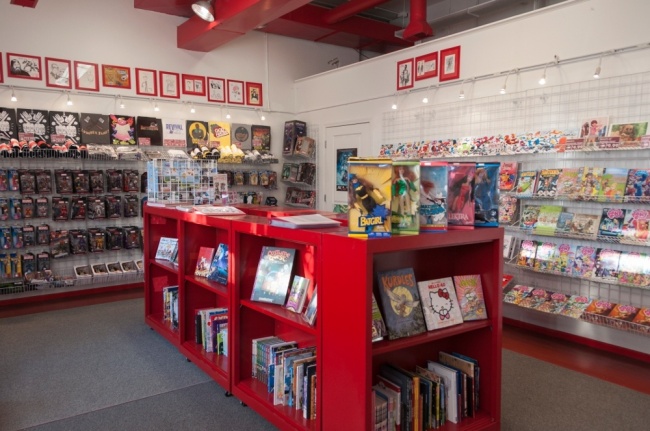

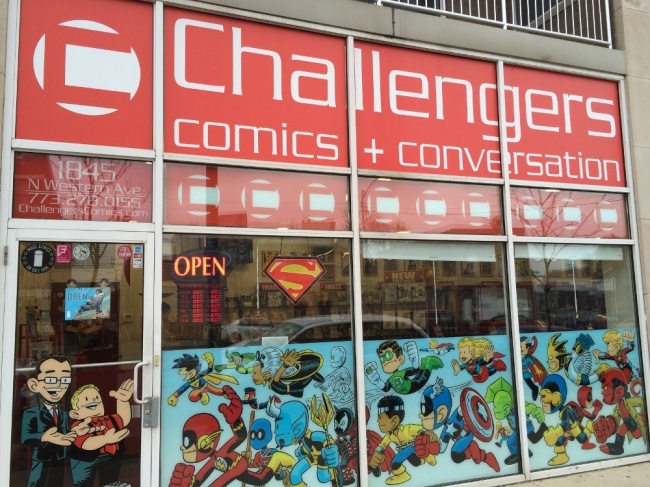
 View Gallery: 4 Images
View Gallery: 4 Images